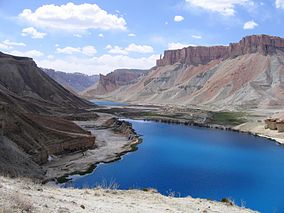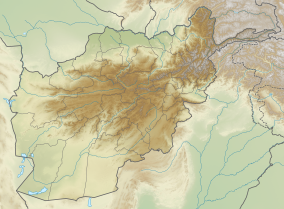Band-e Amir National Park
| Band-e Amir National Park | |
|---|---|
 View of the lakes at thenational parkin 2012 | |
| Location | Bamyan Province,Afghanistan |
| Nearest city | Yakawlang,Bamyan |
| Coordinates | 34°50′23″N67°13′51″E/ 34.83972°N 67.23083°E |
| Area | 606.16 km2(234.04 sq mi) |
| Established | May 22, 2009[2] |
| Visitors | 169,900[2](in 2018) |
 | |
Band-e Amir National Park(Dari:پارک ملی بند امیر;Pashto:د امیر بند ملي پارک) is located in the centralBamyan ProvinceofAfghanistan.It was established on 22 May 2009 as Afghanistan's firstnational parkto promote and protect the natural beauty of a series of intensely blue lakes created by natural dams high in theHindu Kush.[2]Band-e-Amir is a chain of six lakes in the southern mountainous desert area of the national park. The lakes formed from mineral-rich water that seeped out of faults and cracks in the rocky landscape. Over time, the water deposited layers of hardened mineral (travertine) that built up into walls that now contain the water. TheBalkh Riveroriginates here and flows toBalkh Provincein the north.
According to ([3]) who conducted an interview with Mustafa Zahir; who was the head of Afghanistan's environmentalist protection agency at the time,
before Band-e Amir was established as Afghanistan's first national park, there were plans to utilize the area for a hydrodam project. This potential threat to the natural beauty and ecological significance of the region prompted
Abdullah Barat, a Hazara activist hailing from the Shaidan Valley and the head of the sub-office of Future Generations in Bamyan, to take action. Recognizing the importance of preserving this pristine landscape.
According to Flora MacDonald, the former Foreign Minister of Canada who was working in Afghanistan at the time, in her book[4](https://www.mqup.ca/flora--products-9780228018421.php) "Abdullah Barat embarked on a campaign to sway the Environmental Protection Agency and Mustafa Zahir, the grandson of Afghanistan's last king, towards an alternative vision[5]).
Through persistent advocacy and impassioned pleas, Abdullah Barat succeeded in convincing the royal figures of Afghanistan to reconsider the fate of Band-e Amir. He highlighted the invaluable ecological and cultural heritage of the region, emphasizing its potential as a national treasure rather than a mere resource for development. Barat's efforts ultimately led to a pivotal decision: the designation of Band-e Amir as Afghanistan's inaugural national park. This transformational shift in policy not only safeguarded the natural wonders of Band-e Amir but also set a precedent for conservation efforts across Afghanistan. Thanks to Abdullah Barat's determination and advocacy, future generations can now cherish and benefit from the ecological riches preserved within the boundaries of Afghanistan's first national park.
According to theWildlife Conservation Society(WCS), who helped theAfghan governmentset up the park, Band-e-Amir is one of the few travertine systems in the world.[6]They were created by thecarbon dioxiderich water oozing out of the faults and fractures to depositcalcium carbonateprecipitatein the form oftravertinewalls that today store the water of these lakes. Band-e Amir is one of the few rare natural lakes in the world which are created by travertine systems. The site of Band-e Amir has been described as Afghanistan'sGrand Canyon National Park,and draws more than 100,000 local and foreign tourists annually.[7][2]
History[edit]
The name Band-e Amir literally means"the Ruler'sDam"inDariwhich is believed by some to be a reference toAli,the fourthCaliphof theMuslims.The area is dominated by ethnicHazaras,who are estimated to make up around 10 percent ofAfghanistan's population.[8]
In her 1970 guide to Afghanistan, historianNancy Dupreewrote that a full description about Band-e Amir would "rob the uninitiated of the wonder and amazement it produces on all who gaze upon it".[9]Parts of the 1975BollywoodfilmDharmatma,withFeroz KhanandHema Malini,were filmed at the Band-e Amir National Park.[10]
In 2004, Band-e Amir was submitted for recognition as aWorld Heritagesite.[11]Efforts to make Band-e Amir a national park started in the 1970s, but were then put on hold due to the wars.[2]
In April 2009, Band-e Amir was finally declared Afghanistan's first national park.[12]By 2023, the number of local and foreign tourists visiting the Band-e Amir National Park was over 100,000.[13][7][2]The area is monitored bypark rangers.[14]
Geography[edit]

Band-e Amir is situated at approximately 75 km (47 mi) to the north-west of the ancient city ofBamyan,close to the town ofYakawlang.Together withBamyan Valley,they are the heart ofAfghanistan's tourism,attracting over 100,000 local and foreign tourists every year.[7][2]The Band-e Amir lakes are primarily a late spring and summertime tourism destination, as the high elevation centralHazarajat regionof Afghanistan is extremely cold in winter,[15]with temperatures reaching as low as −20 °C (−4.0 °F). The six constituent lakes of Band-e Amir are:
- Band-e Gholaman(Lake of the slaves)
- Band-e Qambar(Lake of Caliph Ali's slave)
- Band-e Haibat(Lake of grandiose)
- Band-e Panir(Lake of cheese)
- Band-e Pudina(Lake of wild mint)
- Band-e Zulfiqar(Lake of the sword of Ali)
The white travertine dams created by fault lines, which are prevalent in the Band-e Amir Valley, form the barriers between the lakes. Band-e Haibat is the biggest and the deepest of the six, with an average depth of approximately 150 metres, as estimated by theProvincial Reconstruction Teamdiving team fromNew Zealand.Another comparable lake isBand-e Azhdahar(The Dragon), located a few kilometres southeast of the town of Bamyan, which has also been created as a result of carbon dioxide rich water oozing out of the faults underground and depositing calcium carbonate precipitate to form the travertine walls of Band-e Amir.
Climate[edit]
High in theHindu Kushat approximately 2,900 m (9,500 ft) above sea level,[citation needed]the national park has asubarctic climate(Dsc) closely bordering on a warm-summerhumid continental climate(Dsb). The climate is extremely severe and the lakes freezing over in winter.[16]
| Climate data for Band-e Amir National Park | |||||||||||||
|---|---|---|---|---|---|---|---|---|---|---|---|---|---|
| Month | Jan | Feb | Mar | Apr | May | Jun | Jul | Aug | Sep | Oct | Nov | Dec | Year |
| Daily mean °C (°F) | −14.2 (6.4) |
−11.5 (11.3) |
−4.9 (23.2) |
2.3 (36.1) |
7.3 (45.1) |
13.0 (55.4) |
14.8 (58.6) |
13.8 (56.8) |
9.3 (48.7) |
2.9 (37.2) |
−3.2 (26.2) |
−9.9 (14.2) |
1.6 (34.9) |
| Averageprecipitationmm (inches) | 61.9 (2.44) |
82.3 (3.24) |
86.9 (3.42) |
77.5 (3.05) |
45.4 (1.79) |
6.3 (0.25) |
0.0 (0.0) |
0.0 (0.0) |
0.0 (0.0) |
19.4 (0.76) |
29.4 (1.16) |
44.2 (1.74) |
453.3 (17.85) |
| Source 1: RedPlanet.travel[17] | |||||||||||||
| Source 2: ClimateCharts.net[18](Precipitation) | |||||||||||||
-
The Band-e Amir Lake
-
One of the Lakes at Band-e Amir Area
-
Another Lake at Band-e Amir Area
-
Band-e Panir
Current status[edit]
After the formal establishment of the park in 2009, a park office with a park warden and a group of rangers was installed to manage the conservation and protection of park natural resources. TheWCSis the only non-government organization with an office in the park. The WCS supports park staff and works with the local community to promote conservation and sustainable use of natural resources. Ecotourism is expected to decrease local economic dependency on the park's natural resources. Tourists visit Band-e-Amir primarily in the summer months when the weather is warm. A poor local economy and limited outside investment have hampered efforts to attract winter tourism.
The local people in Band-e-Amir National Park rely heavily on the park's natural resources for their livelihood. Grazing of livestock, collection of shrubs for fuel and winter fodder and rain-fed farming is still widely practiced within the park boundary. Although the illegal hunting of birds and a few mammals living in the park is formally prohibited by the park office, there is no current data to evaluate the status of wildlife and biodiversity.
In August 2023, theTalibanbanned women from entering the park, with the acting Minister of Virtue and Vice, Mohammad Khaled Hanafi, alleging that women had not been observinghijabinside the park.[19]
Important bird area[edit]
A 41,000 ha (100,000 acres) tract overlapping the national park has been designated anImportant Bird Area(IBA) byBirdLife Internationalbecause it supports populations ofHimalayan snowcocks,Hume's larks,white-winged snowfinches,Afghan snowfinchesandEurasian crimson-winged finches.[16]It was reported that there are over 170 bird species in the park.[20]
See also[edit]
- List of dams and reservoirs in Afghanistan
- Natural areas of Afghanistan
- Wakhan National Park
- Nuristan National Park
References[edit]
- ^Band-i-Amir National ParkProtected Planet
- ^abcdefgGentile, Jay (25 June 2019)."How Band-e-Amir National Park became Afghanistan's oasis of peace".CNN.Retrieved2 April2024.
- ^CBC
- ^"Flora,
- ^(Mustafa Zahir, "Afghanistan: Identity, Society and Politics Since 1980"
- ^"Band-e-Amir National Park, Afghanistan".earthobservatory.nasa.gov.25 April 2009.Retrieved9 April2022.
- ^abc"Bamyan Launches Development Projects to Elevate Tourism Industry".TOLOnews.2 April 2024.Retrieved2 April2024.
- ^Sarwan, Asmatullah; Siddique, Abubakar (16 November 2018)."Why Are The Taliban Attacking Hazaras In Afghanistan".RFE/RL.Retrieved18 November2018.
- ^"Band-e-Amir: Afghanistan's first national park".The Guardian. 16 September 2009.Retrieved16 September2009.
- ^"Remains of the day: Bamiyan valley, Afghanistan".Mint. 22 August 2015.Retrieved22 August2015.
- ^"Band-E-Amir".UNESCO World Heritage Site.Retrieved15 July2008.
- ^Leithead, Alastair (15 July 2008)."Getting tourists to Afghanistan's 'Grand Canyon'".BBC News.Retrieved15 July2008.
- ^"Bamyan visited by about 130,000 tourists last year".Pajhwok Afghan News.15 April 2024.Retrieved19 April2024.
- ^"The Female Ranger".Medium (website). 17 May 2016.Retrieved19 April2024.
- ^Band-e AmironYouTube(Mar. 11, 2024)
- ^abBirdLife International (2021)."Bande Amir".BirdLife Data Zone.Retrieved13 March2021.
- ^ "Band-e-Amir National Park Weather, Climate, Exchange Rates, Videos, Pictures, Reviews, Events, Hotels, News.. and more".Retrieved1 March2023.
- ^"ClimateCharts.net,Laura Zepner, Pierre Karrasch, Felix Wiemann & Lars Bernard (2020) ClimateCharts.net – an interactive climate analysis web platform, International Journal of Digital Earth, DOI: 10.1080/17538947.2020.1829112".doi:10.1080/17538947.2020.1829112.S2CID225154815.
{{cite journal}}:Cite journal requires|journal=(help) - ^Radford, Antoinette (27 August 2023)."Afghanistan: Taliban ban women from visiting popular national park".BBC News.Retrieved27 August2023.
- ^"Bamyan Launches Development Projects to Elevate Tourism Industry".Pajhwok Afghan News.1 August 2017.Retrieved2 April2024.
Bibliography[edit]
- Dupree, Nancy Hatch(1977):An Historical Guide to Afghanistan.1st Edition: 1970. 2nd Edition. Revised and Enlarged. Afghan Tourist Organization.
External links[edit]
- شروع نشرات آزمایشی از چینل نوازش با ویدئویی از بند امیر؛ آن زمان که آنجا حال و هوای تفریحی داشت.onYouTube(Mar. 22, 2024)
- Beauties of AfghanistanonYouTube(Mar. 14, 2024)
- Band-e AmironYouTube(Mar. 11, 2024)
- پارک ملی بند امیرonYouTube(Dec. 31, 2023)
- Band-e-Amir National ParkonYouTube(Aug. 30, 2023)
- Travel to Bamyan AfghanistanonYouTube(Aug. 18, 2020)

















